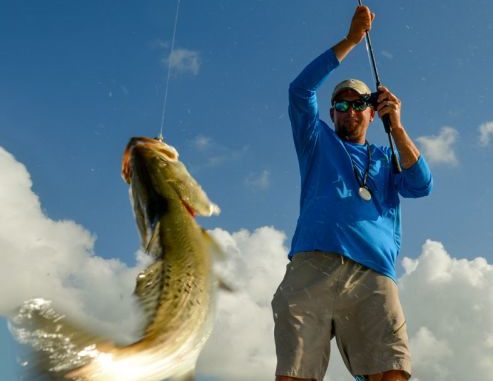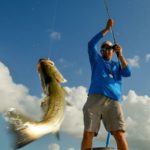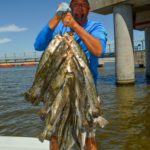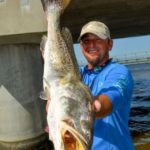
When you think of trophy trout, what lake instantly comes to mind? It’s likely Sabine Lake isn’t it, but this guide knows it holds monsters — and he has the inside track on catching them.
We could be launching into a lake on Mars for all that most Louisianans would know about this place. There was enough daylight at the ramp to reveal that every vehicle already on the lot carried Texas license plates.
But in Louisiana we were, at a small, no-frills boat launch set off the shoulder of Highway 82 where it crosses the lower end of Sabine Lake, the border lake between Louisiana and Texas.
It was a bare-bones setup, the ramp only wide enough to comfortably launch two boats at a time: no bait shop, no snack shop, no tackle store, no bathrooms.
There are six boat launches on the Texas side, yet still they come here.
Why?
Most of it is probably the more-liberal Louisiana limits (more on that later), but that doesn’t explain the near absence of Louisiana fishermen using the lake.
Strangely, the lake is a secret largely in the pocket of Texas fishermen.
You don’t have to spend much time in Port Arthur or Beaumont to learn how they feel about the water body. They simply call it “the lake,” as if it’s theirs and there is no other place.
They talk about big trout, too — sows blowing up topwater lures and scarfing up plugs, plastics and live bait.
Louisiana folks stop short, usually at famed Calcasieu Lake, affectionately called Big Lake.
I wanted to try some Sabine Lake on for size. But private boat anglers who fished the lake had lockjaw. They just wouldn’t talk.
As for Louisiana guides — well, t’wern’t none, at least that I could find.
When I finally picked up Robbie Trahan’s trail, he didn’t seem to feel a strong urge to take an outdoors writer fishing in his honey hole.
It took two years, but finally the Bayou Guide Service owner relented.
And rather than being cagey, I found him to be entertaining and a skilled speckled trout fisherman.
He was making a fun trip with his pal, Mark Driscoll, who I got to know the night before over plates of delicious seafood (See this month’s column of The Louisiana Seafood Bible in this issue) prepared by Trahan.
The first order of business after launching was bait — and Trahan knew where to get it. He turned the boat south and ran down Sabine Pass toward the Gulf of Mexico.
This wasn’t a wilderness. The entire Texas side of Sabine Lake and most of the pass is heavily industrialized (compared to the Louisiana side, which is almost pristine). Every industry is serviced by vessels that use the waterway.
Huge seagoing ships loomed over tiny fishing boats. Powerful tugboats dragging huge swells dominated the pass, and none of them slowed down for fishing craft. You either had enough boat under you to deal with it or you didn’t.
When the boat popped out of the land-bound part of the pass, two paralleling rock riprap jetty walls seemed to extend into the Gulf forever on either side of the pass.
But Trahan’s practiced eye had already spotted a gap in the rocks — a notch called the Louisiana Cut because it is on the Louisiana side of the pass.
Once through the cut, he eyeballed his depth finder and noted 15 feet of water before directing Driscoll to take the wheel so he could set out his 16-foot bait trawl.
He was looking for croakers, his key to hot-weather speckled trout fishing.
At the end of the 15-minute tow, Trahan hauled the otter doors aboard and hand-over-handed the net in.
“We got gold,” he sang out to Driscoll, as the trawl bag came out of the water with hundreds of croakers in it singing in a croaking, froggy chorus.
He emptied the trawl bag on the deck, and the two men set to work quickly sorting the catch before it died.
Out of habit, since the average charter customer doesn’t know the ropes, Trahan issued a constant stream of unnecessary advice to the experienced Driscoll.
“Don’t keep the sand trout,” the guide instructed. “Don’t keep the spot croakers (aka sand diggers); they ain’t worth a flip.”
They sorted the croakers into two 5-gallon buckets that in turn were emptied into two livewells.
They kept only about 120 of the 300 or so croakers caught in the drag.
Bait secured, Trahan charged the boat back up the pass to what he called Lighthouse Cove, a large indentation in the bank on the Louisiana side of the channel, just north of the rocket-like Sabine Pass Lighthouse.
The cove is a large, 4-foot-deep shell pad that comes up abruptly from the 40-foot deep channel. Not having to have made a bait run, scads of boats were already working the area, which Trahan described as a “good spot year-round.”
“This is a meat stop — good for a lot of smaller fish, but in big numbers,” he said.
A few of the anglers in the other boats were catching trout, all on soft plastics.
Trahan started fishing with a chartreuse plastic shrimp imitation, but he clearly lacked confidence in the fake.
He grabbed his bait dip net.
“Lemme try a small croaker,” the captain murmured.
After stripping the plastic off the ¼-ounce jighead, he impaled the hook through the tail of the little bait fish. Driscoll followed his lead, and with that the race was on.
It seemed like every cast produced a speck, or at least a strike.
It was a tough spot to fish because of the dense bed of oyster shells on the bottom. They had a lot of hang-ups and break-offs, even using technique to keep off the bottom. They held their rod tips up high and semi-suspended their hooks over the shells with light bounces while slowly retrieving them.
Both were deliberately selecting small “bite-sized” croakers, planning to save the bigger ones for big trout later. With these small croakers, there was no reason to let a trout reposition the bait in its mouth before striking.
They changed their baits often.
“I want a wiggler,” Trahan explained.
He dipped a couple of net-fulls of croakers from the livewell at a time and placed them in a 5-gallon bucket positioned between the two men.
Their success was attracting attention. A boatload of anglers trolled to within hailing distance.
“What are y’all using?” one of them yelled.
“We’re using market monkeys,” the good-natured smart-aleck guide replied.
“Whaat?” was their bewildered reply?
“We’re using croakers,” Trahan said with a grin.
The entire time they were whacking these nice 14-inch to 2-pound trout, Trahan kept promising bigger fish, sneeringly dubbing what they were catching as “guide trout” or “pickles.”
Suddenly, Trahan shook himself out of his zone. They had over half of their limits made and needed to move to bigger fish before they limited out.
He picked up his Power-Poles and chugged up the channel into the entrance of the receiving terminal for the Cheniere LNG Terminal.
Under development for liquefaction instead of regasification, access to the forest of concrete pilings was unrestricted. Trahan trolled the boat into the cool shade provided by the massive infrastructure.
Besides the structure provided by the pilings, the bottom 8 feet under the boat was paved with rock riprap.
There wouldn’t be any jigheads used here. Instead, they free-lined their croakers using a 3/0 kahle hook, again hooked in front of the tail.
The water looked like the devil — almost muddy.
Still, Trahan scored almost instantly with a 19-incher, what would be the smallest of the day from the spot. The rest were all 3 to 4 pounds, with a few substantially larger.
It was exciting. Hooked speckled trout as long as a man’s leg rolled to the surface in the murky water. Every fish had to be netted; these were too big to flip into the boat.
Sometimes both men had a fish on at the same time.
All the while, Trahan had to keep the boat positioned with his trolling motor because the water was too deep for Power-Poles and the bottom was too rocky to anchor.
It was over quickly. They slammed the limit, all big fish.
Although I knew the answer, I had to ask Trahan how Sabine Lake compared to Calcasieu Lake. The passion in his answer is what surprised me.
“I absolutely hate Calcasieu Lake,” he fairly spat. “Way too many fishing guides; too many boats; too crowded! I haven’t fished there in four years. I’ve run a few trips there — I hated it!
“Everybody talks about the big fish at Calcasieu. We have trout just as big — bigger!”
Editor’s note: Capt. Robbie Trahan of Bayou Guide Service can be reached at 337-309-7881.


